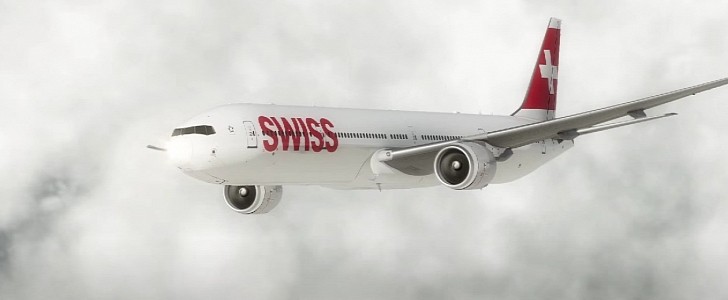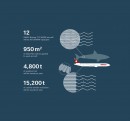Swiss Air Lines (SWISS) announced that it will gradually equip its Boeing 777-300ER fleet with new AeroSHARK aircraft skin technology. As a result, the aircraft will be more fuel-efficient and produce less carbon dioxide emissions.
This new surface technology was developed jointly by Lufthansa Technik and chemicals and coatings manufacturer BASF. AeroSHARK is made up of millions of riblets, which are tiny protrusions measuring 50 micrometers (0.05 mm/0.001 in) in height that replicate the shark skin's hydrodynamic properties.
Applied to an aircraft, this film reduces aerodynamic drag. All twelve Boeing 777-300ER will have their fuselage and engine nacelles covered by the AeroSHARK technology. A total of 950 square meters (10,226 square feet) of this innovative film will be used.
Once the modification is completed, drag on the aircraft is expected to be significantly reduced. And since will aerodynamic drag reduction plays an important role in minimizing fuel consumption, the fleet will be able to save more than one percent jet fuel. This, in turn, will also reduce carbon dioxide emissions.
SWISS estimates that this will translate as more than 4,800 tons of fuel saved and around 15,200 tons of carbon dioxide avoided every year. To put it into perspective, these numbers would be achieved on approximately 87 long-haul flights from Zurich, Switzerland, to Mumbai, India.
Starting from mid-2022, the airline will equip its Boeing 777-300ER fleet successively with AeroSHARK. The work will be done during layovers.
However, Lufthansa Technik and BASF do not want to stop here. The companies are planning to develop new technology that can be applied in the future to different types of aircraft and cover even larger surfaces. This will help provide airlines and manufacturers all over the world with a product that could help them achieve their emission targets.
According to Lufthansa Technik, the sharkskin technology in its maximum expansion stage might be capable of reducing CO2 emissions by up to three percent.
Applied to an aircraft, this film reduces aerodynamic drag. All twelve Boeing 777-300ER will have their fuselage and engine nacelles covered by the AeroSHARK technology. A total of 950 square meters (10,226 square feet) of this innovative film will be used.
Once the modification is completed, drag on the aircraft is expected to be significantly reduced. And since will aerodynamic drag reduction plays an important role in minimizing fuel consumption, the fleet will be able to save more than one percent jet fuel. This, in turn, will also reduce carbon dioxide emissions.
SWISS estimates that this will translate as more than 4,800 tons of fuel saved and around 15,200 tons of carbon dioxide avoided every year. To put it into perspective, these numbers would be achieved on approximately 87 long-haul flights from Zurich, Switzerland, to Mumbai, India.
Starting from mid-2022, the airline will equip its Boeing 777-300ER fleet successively with AeroSHARK. The work will be done during layovers.
However, Lufthansa Technik and BASF do not want to stop here. The companies are planning to develop new technology that can be applied in the future to different types of aircraft and cover even larger surfaces. This will help provide airlines and manufacturers all over the world with a product that could help them achieve their emission targets.
According to Lufthansa Technik, the sharkskin technology in its maximum expansion stage might be capable of reducing CO2 emissions by up to three percent.






